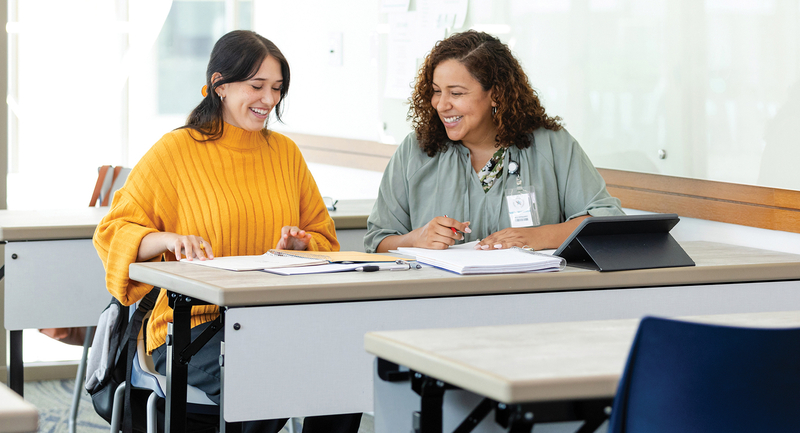November 12, 2020
•
What Special Educators Want Leaders to Know About Remote Education
Dealing with the COVID-19 pandemic has been no easy feat for school systems across the United States. In this new era, special education teachers and service providers (e.g., speech-language pathologists, occupational therapists) have had the extra challenge of implementing individualized education programs (IEPs) while meeting the legal mandates of the Individuals with Disabilities in Education Act. This issue has been exacerbated by the lack of guidance from the United States Department of Education, which has led to hundreds of lawsuits calling into question whether schools are providing an appropriate public education to students with disabilities during the pandemic (Gavin, 2020).
To identify the challenges and successes schools are experiencing, we held focus groups with 15 educators, including special education teachers, related service providers, and administrators from across Silicon Valley. Their answers identify how to support students with disabilities and their teachers more sufficiently in the future.
In the transition to remote learning, many districts focused on developing one cohesive plan for all students. Doing so makes it easier to communicate information to parents and caregivers. But when it comes to special education, individualization is the name of the game.
In special education, plans of the educators we spoke to largely involved moving "minutes" of service online, such as replacing 30-minute weekly group lessons with 30-minute Zoom lessons. Educators and service providers emphasized that these rigid systems do not address the needs of most students with disabilities. Providers who worked with parents to amend IEPs to include specific online learning strategies reported more success overall, even if these changes resulted in fewer "face-to-face" minutes, because they successfully came to a consensus together. This included ensuring that students had consistent access to individual time with their teacher; a balance between live and on-demand learning, with considerations made for individual circumstances and learning activities caregivers could implement offline; open lines of communication to monitor progress online; and an understanding that parents and teachers were partners in the process.
As we move into the extended phases of shutdowns and partial reopenings, educators and service providers should have time to work together toward aligning IEP goals to families' living and learning situations. This could include considering how a student might develop functional skills and communication in the types of activities and routines the family already does at home and consider the routines-based interview used in early intervention to support their children in everyday routines (McWilliam et al., 2009). This view of IEPs as living documents is key for when schools return to full-time face-to-face instruction.
Educators could not overemphasize caregivers' importance, particularly during remote instruction. Younger students require more support to organize materials and log in to class sessions, and older students benefit when adults troubleshoot challenges and provide emotional support. Respondents in our focus groups described different supports for parents and caregivers, including detailed written instructions and district-wide training sessions to introduce the tools that teachers would use.
Although the educators and service providers appreciated these efforts, they also identified pitfalls with these strategies. It is one thing to know about the features of the chosen learning management system generally; it's another thing to understand how a specific teacher will use it. Teachers recommended prioritizing time to meet with parents on a class-by-class basis to discuss how instruction would occur, especially when developing individualized strategies for each student.
Educators recommended that districts provide professional development for building relationships with parents. Because remote instruction has thrust many teachers into the role of "home visitor" in unexpected ways, resources about cultural awareness that build on the successes and lessons from those who work in homes with families regularly (i.e., early interventionists, home healthcare providers) can help teachers navigate new kinds of relationships.
Schools should also consider how to leverage this year's experiences to identify strategies that will maintain a closer home-school connection after the return to face-to-face instruction. Educators and service providers explained that they had a better understanding of students' needs and parents' concerns when they saw where students live. They recommended using web-conferencing programs to continue "home" visits and IEP team meetings with caregivers.
Special educators and service providers are used to changing instruction in direct response to student behavior. But typical strategies, such as using physical proximity, no longer work remotely. The teachers we spoke with were developing ways to get feedback from students in real time, including using hand signals during video meetings, using polling features in webinars, and holding individual or small group meetings.
But even when educators and service providers recognized that students need additional support—such as visual schedules, graphic organizers, or books at different levels—they struggled to get those support materials to students in a timely manner. To reduce exposure, many schools are either mailing materials or designating biweekly or monthly material pick-up dates. Schools may want to consider how to adapt these schedules so that students with different learning needs can access materials more frequently. All participants asked for a continued focus on flexibility.
Moving forward, schools should also consider how to transition the skills teachers develop for remote instruction back into the classroom, such as making room in the schedule for the most tech-savvy teachers to coach colleagues on adapting handouts and worksheets or generating visual schedules to share virtually.
Educators, service providers, and administrators recommended using the universal design for learning (UDL) framework to design remote instruction (CAST, 2018). This included offering students multiple means of instructional content or materials (e.g., instructional videos, podcasts, websites) and providing choice in how students demonstrated their knowledge. We would also recommend the TPACK framework for technological, pedagogical, and content knowledge when selecting and employing technology for teaching (Koehler & Mishra, 2009). Schools may want to consider professional development on how TPACK may support UDL in both remote and face-to-face instruction.
It is no surprise that we are still exploring how to serve students with disabilities in this new instructional context. Rather than creating rigid one-size-fits-none systems, we must continue to leverage the lessons we have learned. Effective use of technology to make learning materials available to students should remain a part of how teachers operate and receive professional development and how pre-service teachers are prepared to support all learners.
References
•
CAST. (2018). Universal Design for Learning Guidelines version 2.2. Retrieved from http://udlguidelines.cast.org
•
Gavin, J. (2020). Are Special Education Services Required in the Time of COVID-19? American Bar Association.
•
Kohler, M. & Mishra, P. (2009). What is technological pedagogical content knowledge (TPACK)? Contemporary Issues in Technology and Teacher Education, 9(1), 60-70. Retrieved from https://www.learntechlib.org/p/29544/
•
McWilliam, R. A., Casey, A. M., & Sims, J. (2009). The routines-based interview: A method for gathering information and assessing needs. Infants & Young Children, 22(3), 224-233.







